What to Wear Paddle Boarding: Essential Gear Guide
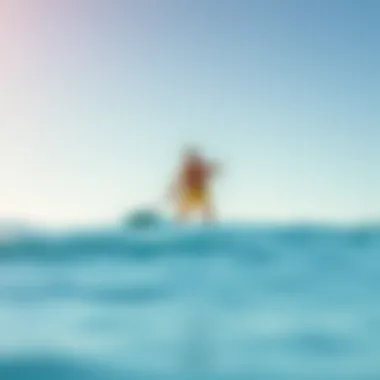
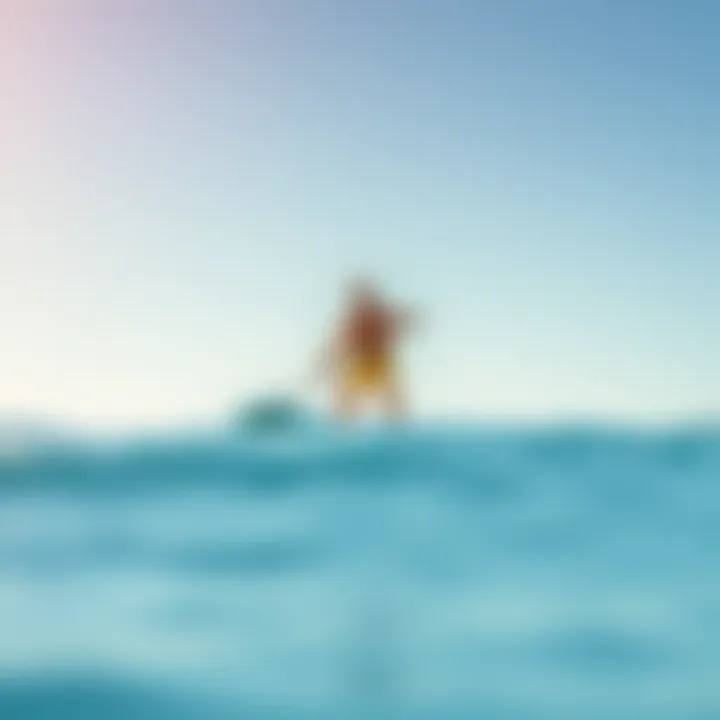
Intro
When it comes to stand up paddle boarding, the right attire can make a world of difference. Comfort and performance are intertwined on the water, as the clothing you choose directly impacts your experience. It's more than just grabbing a swimsuit or a pair of shorts. Considerations such as weather conditions, water temperature, and even personal preferences all play a role in what you should wear. By the end of this guide, paddlers—whether you're just starting or you've been at it for years—will have a clearer idea of what gear and attire will best suit your next adventure.
The Importance of Choosing the Right Attire
Selecting the right outfit is not merely for aesthetics; it affects your agility, warmth, and ultimately your enjoyment on the water. For instance, dressing for a sunny day in July is hugely different from gearing up for a brisk autumn morning. The attire needs to be functional—efficiently allowing for movement while also providing a barrier against elements.
As you gear up for your next paddle outing, remember that understanding your environment is vital. Are you facing choppy waters? Is it a calm lake or a bustling coastline? These factors can dictate your material choices, fitted gear, and any additional accessories you might want to keep in mind.
"What you wear can either enhance or restrict your paddle boarding experience, so choose wisely!"
Breaking It Down: Key Factors to Consider
Here's what we'll dive into:
- Water Temperature: Understanding how it influences your clothing decisions.
- Weather Conditions: From sunny to stormy, how to prepare.
- Materials & Styles: The nitty-gritty of what works best for paddlers.
- Accessories & Extras: Those important little things that can make a big difference.
By breaking it down into these categories, we aim to equip you with the knowledge needed to conquer any body of water you choose to explore.
Enthusiasts will leave with more than just a list of recommended items. This guide aims to illuminate the why behind each choice—something that can often be overlooked but is just as crucial as the gear itself. Keeping your comfort and performance top of mind will lead to more enjoyable, successful outings on the water.
Understanding the Essentials
Selecting the right attire for stand up paddle boarding (SUP) goes beyond mere aesthetics; it directly affects your comfort and performance while experiencing the beauty of nature on the water. Each piece you choose acts as a barrier against the elements, ensuring you remain focused on your paddling rather than discomfort. Moreover, proper attire can enhance your mobility, permitting graceful strokes and agile maneuvers. This section delves into the fundamental purpose of sporting the right gear when paddle boarding and sheds light on pivotal factors including weather conditions and water temperature that should inform your choices.
Purpose of Attire in Paddle Boarding
When you paddle, every stroke demands a certain level of physical activity. Wearing the right clothing is essential to keep you dry, insulated, and free to move. Think about it—tight-fitting shorts or a heavy cotton tee can restrict your movement, making it difficult to balance on the board. Choosing attire designed for performance, like moisture-wicking fabrics, means you won’t have to deal with unpleasant sogginess that can lead to chafing or discomfort. Additionally, proper clothing can protect you from UV rays, reducing the risk of sunburn during all-day excursions on the water.
Not every paddler realizes the strategic advantage that comes from layering attire. Different layers can serve various functions; for example, a moisture-wicking base layer can remove sweat from your body, while a top layer may provide UV protection or stave off wind chill if you end up on the water during cooler times of the day. A well-planned outfit not only optimizes performance but also guarantees safety on the water.
Impact of Weather Conditions
Weather conditions play a decisive role in your paddle boarding experience. Sun, wind, rain—these elements will dictate your clothing choices. On sunny days, breathable materials that keep you cool are essential, as overheating can lead to fatigue and dehydration. Look for long sleeves that offer UV protection without stifling airflow.
Windy conditions can introduce a chill to your experience, especially if you're paddling at dawn or dusk. In such cases, a light windbreaker can be invaluable. The last thing a paddler wants is to catch a chill mid-session, putting a damper on an otherwise enjoyable outing.
Conversely, during adverse weather like rain, waterproof attire becomes invaluable. Configure your outfit so it can handle sudden showers—quick-drying fabrics allow for adaptability, ensuring you can quickly transition from sun to rain without becoming entirely soaked.
Influence of Water Temperature
Water temperature is just as critical as air temperature in shaping your paddle boarding attire. Cold water can sap your energy and increase the risk of hypothermia. Thus, a wetsuit is a wise choice when venturing into frigid waters, providing insulation to keep your core warm despite the icy grip of nature. For warmer waters, a swimsuit or board shorts might suffice, but it's vital to consider your sensitivity to cool water and wind, especially during those cooler months.
On the flip side, if you're zipping across warm summer waters, wearing lighter fabrics can be more enjoyable. However, it’s crucial not to underestimate the dangers of prolonged sun exposure. Choose fabrics designed for water sports that also include UPF ratings to ensure your skin is protected even from the strongest rays.
By thoughtfully aligning your attire choices with weather conditions and water temperatures, you can greatly enhance your paddle boarding experience. Understanding these essentials sets the groundwork for further exploration of specific gear and attire needed to navigate both calm and challenging waters.
Base Layers: What to Wear Underneath
When it comes to stand up paddleboarding, the base layer is much more than just an afterthought. It serves as the foundational garment that directly impacts comfort and performance on the water. Choosing the right base layers is essential for regulating body temperature, managing moisture, and providing an optimal level of flexibility. After all, what you wear underneath can set the tone for your entire paddling experience.
Choosing Appropriate Fabrics
Synthetic vs. Natural Fibers
Choosing the right fabric for your base layer is like picking the right tool for a job; the wrong one can make everything difficult. Synthetic fibers, such as polyester and nylon, have become increasingly popular among paddleboarders. They are known for being lightweight and quick-drying, which is crucial when you’re splashing around on the water.


On the other hand, natural fibers like cotton, while often comfortable, absorb moisture in a way that can leave you feeling soggy and cold. Synthetic fabrics do a much better job at wicking away sweat from the skin and letting it evaporate quickly. This keeps you drier and cooler on hot days, as well as warmer when it’s chilly. The unique feature of synthetic fabrics is their durability; they often withstand rough handling and resist fading or tearing better than their natural counterparts.
While natural fibers may feel soft against the skin, they can become heavy and clingy when wet, creating a discomfort that could ruin your time on the water. Hence, synthetic fibers are the frontrunners for a comfortable experience.
Moisture-Wicking Properties
Moisture-wicking fabrics are an essential aspect of base layering. Essentially, they are like the superhero of paddleboarding attire. These materials pull moisture away from your skin and allow it to disperse, which in turn helps to keep you dry and cool. This can be particularly advantageous in the heat of summer when you expect to work up a sweat.
Some of the best moisture-wicking fabrics contain microscopic fibers that create a larger surface area. This helps them absorb moisture more effectively. The unique feature of these fabrics is their ability to dry quickly, allowing you to stay comfortable even after a good bout of paddling.
In essence, while the structure of the garment is critical, the fabric plays a pivotal role in your satisfaction on the board. Ignoring the moisture-wicking properties could leave you feeling gross and uncomfortable, impacting the enjoyment of your time paddling.
Heat Retention and Breathability
Heat retention and breathability are two sides of the same coin when it comes to base layers. Ideally, you want a layer that keeps you warm when it’s chilly without making you feel like you’re trapped in a sauna. This balance is particularly relevant during early morning paddles or in colder climates.
Some base layers are designed to trap heat close to your body without stifling airflow. This means that when you start to sweat from paddling hard, the fabric allows for evaporative cooling. It's worth noting that not all fabrics achieve this balance perfectly. Therefore, you’ll want to look for those touted as both insulating and breathable.
Ultimately, the goal with base layers is to keep your body comfortable so you can focus on the experience rather than what you’re wearing. The right choices can help ensure that your body feels just right, regardless of whether you’re battling a brisk headwind or soaking up a peaceful sunset on the water.
Top Layer Options
When it comes to paddle boarding, your top layer is a pivotal component of your outfit. It doesn’t just serve to keep you covered; it plays a crucial role in regulating your body temperature, offering protection from sun exposure, and enhancing your overall comfort while maneuvering on the water. Selecting the right top layer can make a significant difference in your experience, whether you’re gliding through calm lakes or tackling challenging waves.
Short Sleeve vs. Long Sleeve Shirts
Choosing between short sleeve and long sleeve shirts ultimately boils down to personal preference, weather conditions, and protection needs.
Performance Tees
Performance tees are designed for active use, which makes them an excellent option for paddle boarding. Typically made from synthetic materials, these shirts excel in moisture-wicking, meaning they pull sweat away from your skin, keeping you dry. The quick-drying capability is also a strong suit, which is something every paddle boarder values during a long day on the water.
The breathable fabric helps regulate body temperature. One key characteristic of performance tees is their lightweight feel which allows for unrestricted movement. However, a potential downside is that in particularly chilly waters, they might not provide enough warmth by themselves.
In short, performance tees are beneficial for warm days. They keep you cool and comfortable while paddling.
UV Protection
UV protection is another critical element to consider when selecting your paddle boarding attire. Shirts that offer UV protection shield your skin from harmful rays, which can lead to sunburn or long-term skin issues. The most notable quality of these garments is their special fabric treatment or construction that blocks a significant percentage of UVA and UVB rays.
Opting for tops with UV protection is popular for a good reason: it allows you to enjoy your time on the water without constantly worrying about reapplying sunscreen. Yet, there can be a trade-off; these shirts can sometimes feel heavier or less breathable than standard options. For active paddle boarders, balancing comfort with protection is key. Consider the climate and duration of your activities to determine if these shirts are right for you.
Wetsuits: When and Why to Wear
Wetsuits can be a game changer depending on the conditions. They are ideal for cooler water temperatures as they provide insulation while also allowing for flexibility. A properly fitted wetsuit traps a thin layer of water between your body and the suit, warming it up with your body heat. This feature makes wetsuits remarkably effective for maintaining body heat in colder climates. Knowing when to wear a wetsuit depends on a few factors– the water temperature, your tolerance for cold, and the length of your paddle boarding session.
Rash Guards: Benefits and Usage
Rash guards serve multiple purposes and should not be overlooked. They offer a great way to prevent chafing from the paddle or the board, making them an excellent choice for longer excursions. Made from a stretchy, quick-drying fabric, rash guards provide comfort and freedom of movement. They also offer some level of UV protection, making them a versatile option for sunny days.
In summary, both rash guards and wetsuits can add layers of protection and comfort. Assess the conditions you plan to paddle in and choose accordingly to enhance both your enjoyment and safety on the water.
Bottom Wear for Paddle Boarders
When it comes to stand up paddle boarding, the right bottom wear can make a world of difference. Whether you're gliding across calm waters or navigating through choppy seas, what you put on your legs holds significant importance. Selecting the right attire not only contributes to comfort but also influences your performance and enjoyment on the water. The goal is to find something that provides ease of movement while still offering protection against the elements.
Board Shorts vs. Swim Trunks
The debate between board shorts and swim trunks is an age-old one among paddle boarders. Both clothing types serve the basic purpose of providing comfort in and out of the water, but they do have distinct advantages and recommended situations for use.
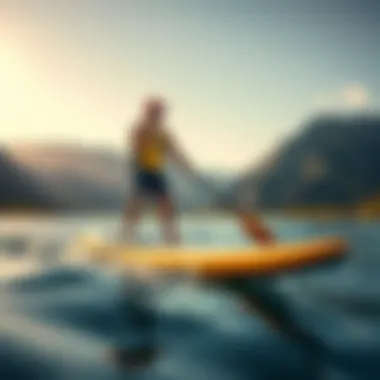
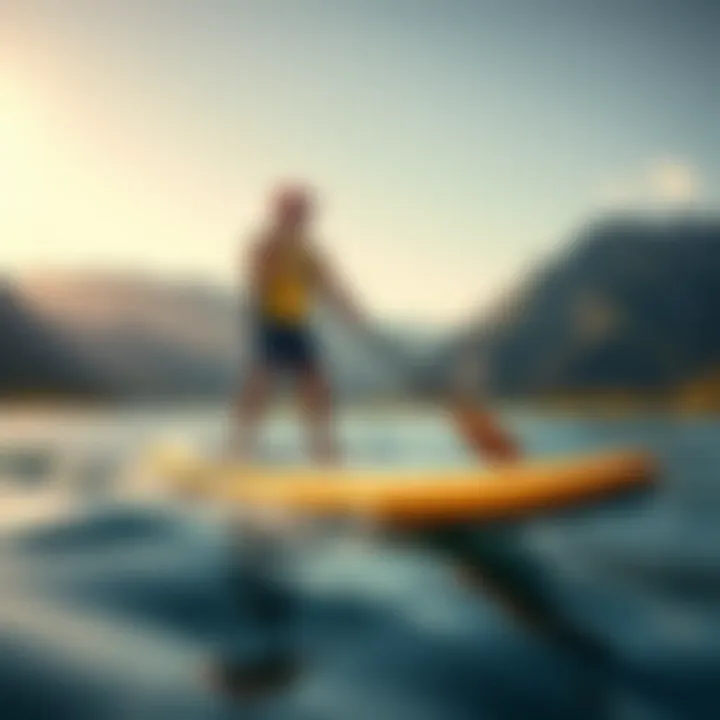
Board shorts typically feature a longer cut, often extending down to the knee or mid-thigh, making them a popular choice for paddlers. They are often made of quick-drying fabric, which is excellent for those who might be splashing around. The added length helps protect the wearer from sun exposure and potential scrapes from the board or other equipment. Also, many board shorts come equipped with pockets, offering convenient storage space for small items like keys or snacks.
On the other hand, swim trunks tend to have a shorter design and are often more fitted. They might be more appealing for those who prefer a less bulky feel. However, they may not provide the same level of sun protection as board shorts and can offer less warmth in cooler waters. The trade-off between comfort and functionality really depends on personal preference and specific paddle boarding conditions. Here are a few points to consider:
- Board shorts provide better sun protection.
- Swim trunks generally allow for greater mobility.
- Fabric type can affect drying time and overall comfort.
- The style you choose may influence your confidence while paddling.
A handy rule of thumb is to wear what makes you feel good and works best for the conditions of the day.
Leggings for Women: Comfort and Flexibility
For female paddle boarders, leggings can be an outstanding choice. They offer a fantastic combination of comfort, flexibility, and style. Made from stretchy and breathable materials, leggings allow for full range of motion, essential when balancing on a paddleboard. Women can choose from various options, including high-waisted styles, which often provide extra support and coverage.
Leggings also come in different thicknesses, which is key for adapting to water temperatures. For warmer conditions, lightweight leggings can provide just enough coverage without causing overheating. Conversely, in cooler climates, opting for thicker thermal leggings can help retain warmth and protect against the chill of the water.
Additional benefits include:
- Moisture-wicking capabilities that keep you dry and comfortable.
- UV protection from the sun's rays, a feature many leggings offer.
- Durable fabrics that stand up to the rigors of paddling.
Ultimately, when selecting bottom wear for paddle boarding, consider not just the aesthetics but the functional attributes that align with your paddling style and preferences. With the right gear, you'll not only perform better but enjoy your time on the water more fully.
Footwear Considerations
Choosing the right footwear for stand up paddle boarding isn't just about style; it directly affects your performance, comfort, and safety on the water. As you navigate varying water conditions, ensure your feet are well cared for. Selecting appropriate footwear allows you to paddle with confidence and engage with the water more effectively.
Water Shoes: Features to Look For
Water shoes play a vital role in enhancing your paddling experience. Unlike regular athletic shoes, water shoes are designed for the specific demands of aquatic activities. Here are some essential features to consider when choosing water shoes:
- Drainage Systems: The best water shoes have drainage ports, allowing water to escape easily. This keeps your feet lighter and more comfortable.
- Grip and Traction: Look for shoes with non-slip soles. A good grip is crucial for stability on slippery surfaces, ensuring you don't take an unexpected dive.
- Breathability: Shoes that incorporate breathable materials keep your feet cool, reducing irritation and discomfort during long sessions.
- Secure Fit: Adjustable straps or elastic bands help maintain a snug fit, preventing any accidental slips or movements.
Choosing the right pair of water shoes ensures that you can move on and off your paddleboard with ease while protecting your feet from rugged terrain and unseen underwater obstacles. Durable and snug, these shoes provide confidence and relief from the stresses that aquatic environments can impose on your feet.
Flip Flops: Pros and Cons
When it comes to casual footwear, flip flops often come to mind. They are easy to slip on and off, making them a popular choice for many paddlers. However, flip flops come with both advantages and drawbacks:
Pros:
- Convenience: Perfect for quick transitions between the land and board, flip flops are easy to put on, allowing you to get in and out of the water with minimal fuss.
- Lightweight: They are easy to carry and provide little bulk when packing for your day out.
- Affordable: Generally, flip flops are cost-effective. You can often find a decent pair without breaking the bank.
Cons:
- Lack of Support: They do not provide the arch support you might need for prolonged standing on a board, possibly leading to discomfort.
- Limited Traction: On wet surfaces, flip flops can be slippery, increasing the chance of falls or slips while getting on or off your paddleboard.
- Poor Protection: Your feet are more exposed to sharp rocks and debris when wearing flip flops, posing a risk to your safety on the water.
In summary, while flip flops might suit a casual day at the beach, they fall short when it comes to the demands of stand up paddle boarding. Though they serve a purpose, consider opting for more suitable options like water shoes that can provide adequate protection and support.
Safety Gear and Accessories
When it comes to stand up paddle boarding, dressing appropriately goes beyond just choosing the right clothes. Safety gear and accessories play a pivotal role in ensuring not only comfort but also safety while you're out on the water. In this section, we'll explore different elements of safety gear, each carefully crafted to enhance your paddling experience and keep you secure.
Personal Flotation Devices (PFDs)
Personal flotation devices, commonly known as PFDs, are arguably the most critical piece of safety equipment for paddle boarders. Wearing a PFD ensures that you stay afloat in case you fall in or encounter unexpected waves. It’s essential to select a PFD that fits snugly but allows for freedom of movement. There are several styles available, such as vests and belt packs; each serves the primary function of keeping you above water but may vary in comfort and mobility.
Take time to check the buoyancy rating, as it is important to choose a device that fits your weight class. Some PFDs come with additional features, like pockets for carrying essentials or reflective materials for visibility. When paddling for long hours, consider a lightweight, low-profile option that won’t restrict your movement while you paddle. Lastly, always check that your PFD is approved by the relevant safety authorities in your area, as this can vary from one region to another.
Sun Protection: Hats and Sunglasses
Sun protection is not just about having fun on the water; it also requires taking care of your skin and eyes. Prolonged exposure to the sun can lead to severe consequences like sunburn and even skin cancer. That's where sun protection gear comes in, specifically hats and sunglasses.
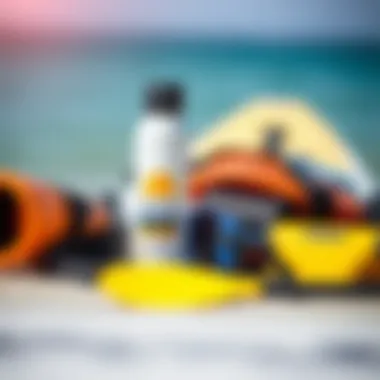
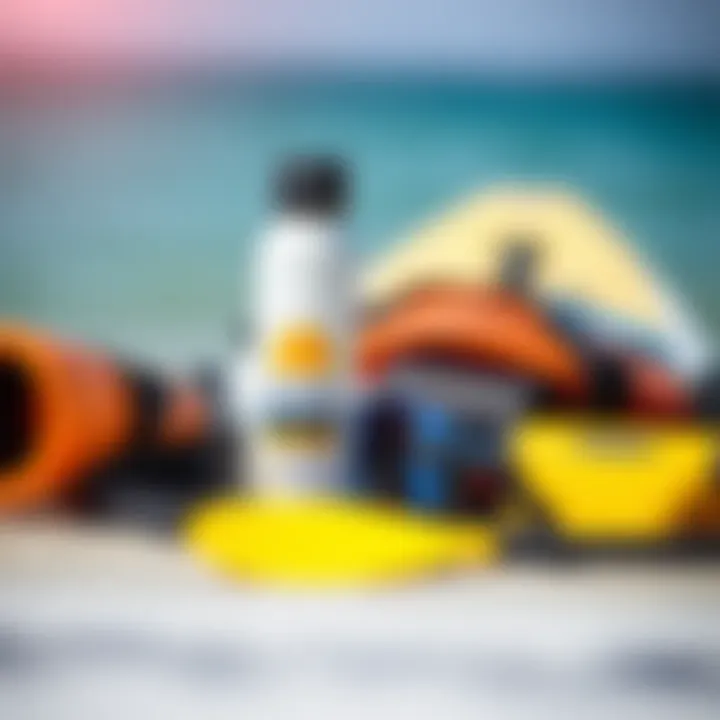
A good wide-brim hat can shield your face and neck from the blazing sun, reducing your risk of overheating and sunburn. Many paddle boarders opt for hats designed with breathable materials to remain comfortable during warm summer days. Furthermore, look for hats with UV protection features to provide additional safety.
Sunglasses are equally important, as they protect your eyes from harmful UV rays and reduce glare from the water's surface. Choose polarized lenses that can enhance visibility and minimize eye strain, allowing for a more enjoyable paddling experience. Options that come with straps are beneficial; they keep the glasses secure, even when the water gets choppy or during sudden falls.
Leashes: Importance and Variability
A paddle board leash is not just a minor accessory; it can literally save your life. When you fall off your board, the leash keeps it tethered to you, preventing the paddle board from drifting away and allowing easy access to climb back on. There are two common types of leashes: coiled and straight.
Coiled leashes sit close to the board when not extended, reducing drag in the water, making them ideal for flat water paddling. On the other hand, straight leashes are excellent for surfing conditions, as they provide a longer length to reach your board when you fall. Consider your paddling environment carefully when choosing your leash. Those venturing into windier or surf conditions should prioritize sturdier leashes that can handle rougher waters.
Having a proper safety gear setup not only sets the tone for a safer outing but also allows you to focus on enjoying your paddle boarding adventure. With the right PFD, sun protection gear, and a reliable leash, you’ll feel secure on the water, making for a much more enjoyable experience.
Seasonal Considerations
Understanding the seasons can play a huge role in planning your stand up paddle boarding adventures. Each season brings its own set of challenges and demands when it comes to choosing the right attire. The fluctuating temperatures and weather conditions necessitate careful consideration of your clothing choices to maintain comfort and safety. By adapting to the seasons, paddlers can fully enjoy their time on the water, no matter the conditions.
Summer Wear: Light and Breathable Fabrics
When the sun shines and the temperatures soar, your choice of clothing should reflect the need for comfort and breathability. In the summer months, opting for light and moisture-wicking fabrics is vital.
These fabrics not only keep you cool but also help draw sweat away from your body, reducing that sticky feeling after a good paddle. Quick-dry materials like polyester or nylon are excellent options that allow for both movement and ventilation. Think about wearing shorts or breathable shirts made from these fabrics.
Also, considering UV protection is key in summer. Look for garments that offer UPF (Ultraviolet Protection Factor) ratings. Some brands have integrated UV-blocking technology into their fabrics, which adds an extra layer of defense against sunburn. A wide-brimmed hat and sunglasses can further shield your face and eyes, helping you stay comfortable under the blazing sun.
- Key Elements for Summer Wear:
- Lightweight and breathable materials
- Moisture-wicking properties
- UV protection
Winter Gear: Insulation and Warmth
As temperatures drop and chilly winds pick up, a different approach is necessary. Winter paddle boarding can be invigorating but requires appropriate insulation and warmth to ensure comfort on the water. Layering becomes a crucial strategy in these colder months. Wearing thermal base layers provides essential warmth without bulk. Look for thermal fabrics with excellent insulation properties, such as merino wool or polyester blends.
A substantial layer on top, like a waterproof and windproof jacket, plays an invaluable role in keeping you dry and warm. Don’t forget to consider accessories like gloves, which can significantly enhance comfort during longer paddles. Neoprene gloves can help maintain dexterity while also providing insulation.
In addition, having the proper footwear is essential. Insulated water shoes or booties designed for extreme conditions can stop those chilly toes from becoming a distraction. As you prepare for a winter adventure, remember that staying dry and insulated is fundamental.
"Adapting your clothing for winter conditions increases your enjoyment and safety, making every paddle a delight rather than a trial."
- Key Elements for Winter Gear:
- Thermal base layers
- Waterproof jackets for wind and rain
- Insulated footwear and gloves
Always remember, regardless of the season, your comfort should guide your wardrobe choices. The right attire not only enhances performance but can also make a huge difference in your overall enjoyment as you explore the waters on your paddle board.
Final Thoughts on Paddle Boarding Attire
Choosing the right attire for stand up paddle boarding isn’t just about following trends; it’s a foundational aspect of the entire experience on the water. Effective attire can elevate not just comfort but also safety and performance. Navigating through varying weather conditions, fluctuating water temperatures, and personal preferences calls for attentive consideration in selecting what to wear while paddle boarding.
Personal Preferences and Comfort Levels
When it comes down to it, paddle boarding is as much about enjoyment as it is about performance. Personal preferences play a significant role in what one might find comfortable during those hours on the water. Factors like fit, style, and flexibility can shift how good or bad the experience might feel.
- Fabric Choices: Some paddlers may lean towards synthetics due to their moisture-wicking qualities. Others might prefer the feel of cotton or bamboo, finding it more pleasant against their skin. Whatever the choice, ensure it aligns with the hours you'll be spending on the water.
- Layering Styles: The layering strategy also reflects individual comfort levels. Some may favor a loose fit allowing for easier movement, while others might prefer something snug to maintain buoyancy. It’s wise to try various configurations and see what feels just right.
Adaptation to Changing Conditions
Paddle boarding can be unpredictable; changes may occur in weather, water state, or even personal energy levels throughout the day. Hence, adapting one's attire to these dynamic conditions is crucial.
- Weather Considerations: A sunny morning can quickly turn into an overcast afternoon. Being prepared in terms of clothing - such as opting for lightweight, packable layers - allows one to easily adjust to cooler snaps or sudden winds.
- Hydration and Temperature: The importance of hydration and temperature regulation cannot be overstated. Wearing breathable fabrics can help manage sweat and body heat, leading to more enjoyment in the long run.
Ultimately, it’s about finding the balance between functionality and style. Comfortable gear paired with a sense of personal expression can enhance the paddle boarding experience significantly. As conditions shift, so too should your choices in gear. Stay adaptable, and you’ll find yourself thriving on the water.
"In paddle boarding, just like in life, adaptability is the key to enjoying the ride."
Explore more about paddle boarding safety and gear considerations on resources like Wikipedia and Britannica for insights alongside community discussions on Reddit.



